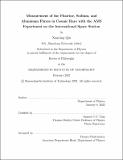Measurement of the Fluorine, Sodium, and Aluminum Fluxes in Cosmic Rays with the AMS Experiment on the International Space Station
Author(s)
Qin, Xiaoting
DownloadThesis PDF (16.95Mb)
Advisor
Ting, Samuel C.C.
Terms of use
Metadata
Show full item recordAbstract
Primary nuclei (He, C, O, Ne, Mg, Si, ...) are thought to be mainly produced and accelerated in astrophysical sources such as the supernova. Secondary nuclei (Li, Be, B, ...) are mostly produced by interactions of primary nuclei with the interstellar medium. Precise knowledge of the secondary-to-primary flux ratio, like B/C, is essential in the understanding of cosmic ray propagation. This thesis presents the first precision measurements of the heavy cosmic ray fluorine (F), sodium (Na), and aluminum (Al) fluxes in the rigidity range from 2.15 GV to 3.0 TV, based on data collected by the Alpha Magnetic Spectrometer (AMS) during the first 8.5 years of operation. The F flux is believed to be the only pure secondary flux between oxygen and silicon, and Na and Al fluxes are thought to be produced both in astrophysical sources and by the collisions of heavier nuclei with the interstellar medium.
The measurements show that the F flux deviates from a single power law above 200 GV. The heavier secondary-to-primary F/Si flux ratio rigidity dependence is distinctly different from the lighter B/O (or B/C) rigidity dependence. In particular, above 10 GV, the [(F/Si)/(B/O)] ratio can be described by a power law 𝑅^δ with δ = 0.052 ± 0.007. This shows that the propagation properties of heavy cosmic rays, from F to Si, are different from those of light cosmic rays, from He to O, and that the secondary cosmic rays have two classes. The Na and Al fluxes are well described by the sums of a primary cosmic ray component (proportional to the Si flux) and a secondary cosmic ray component (proportional to the F flux), similar to the nitrogen (N) flux. The fraction of the primary component increases with rigidity for the N, Na, and Al fluxes and becomes dominant at the highest rigidities. The Na/Si and Al/Si abundance ratios at the source, 0.036 ± 0.003 for Na/Si and 0.103 ± 0.004 for Al/Si, are determined independent of cosmic ray propagation.
Date issued
2022-02Department
Massachusetts Institute of Technology. Department of PhysicsPublisher
Massachusetts Institute of Technology